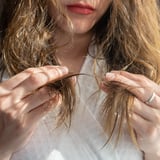As common a problem as hair damage is, it isn’t always super obvious. Sure, you might know that you have thin hair, you might understand that your ends are a little bit dry or that you have an oily scalp, but truly understanding everything there is to know about your hair is nearly impossible. Finding out exactly what your hair needs may feel like a science, but not everyone is a scientist – we can’t all just take a look at a few strands underneath a microscope to determine what’s wrong. If you’ve long suspected that you’ve been struggling with hair damage, there are painless ways to determine if your hair is damaged or not, and we talked to a pro to get to the bottom of it.
Luckily, it won’t require a trip to a science lab or any fancy equipment. According to Devin Toth, a hairstylist at New York City’s Salon SCK, you can start by doing a simple strand test.
Experts Featured in This Article
Devin Toth is a hairstylist at New York City’s Salon SCK.
What Is a Strand Test?
Put simply, a strand test is a way to test your hair’s texture type and its condition. The strand test doubles as a way to determine your hair’s porosity, which is another indicator of how healthy your hair is.
A strand test can also be used by colorists to test out how your hair will react to bleach when coloring it, as well as the appropriate processing time. It’s often used when people are lightening their hair for the first time. In this instance, however, Toth is taking us through how to use a strand test to assess damage.
How to Do a Strand Test
“The easiest way to find out if your hair strands are fine or coarse in texture is to press your thumb and pointer finger onto one strand of your hair and gently glide your fingers down your hair strand from your roots to your ends,” Toth tells PS. “Don’t use any hot styling tools beforehand because this should be done on only natural, dry hair. If the strand feels bumpy, then it is coarse. If the strand feels smooth and silky, then it is fine. That’s your basic strand test.”
If you’ve determined that the strand of hair you used in the strand test is coarse, that means that your cuticles are damaged and open, and your porosity level is high. This kind of hair is often fragile and susceptible to breakage, and can benefit from a protein treatment every four to six weeks. Our current favorite option is the L’Oréal Professionnel Absolut Repair Protein Treatment Hair Mask ($45). Another helpful way to point out damage, according to Toth, is to take a look at the hair’s overall texture now compared to its texture in the past.
“If you’re looking for damage, see if the hair texture feels different on the ends or in the front by your face compared to your root area,” he says. This can be done by simply running your fingers through your hair and paying special attention to any split ends or an uneven wave pattern. For that, you’ll also have to take into account whether or not your hair has recently been cut, heat styled, or color-treated. If this is the case for you, you could benefit from incorporating a weekly deep conditioner into your hair regimen. We love the Oribe Gold Lust Transformative Hair Mask ($69).
– Additional reporting by Renee Rodriguez
Danielle Jackson was a former assistant editor for PS Beauty.
Renee Rodriguez is a staff writer and social producer for PS. She writes across all verticals, but her main areas of expertise focus on fashion and beauty content with an emphasis on reviews and editor experiments. She also produces social content for the PS TikTok and Instagram accounts.




